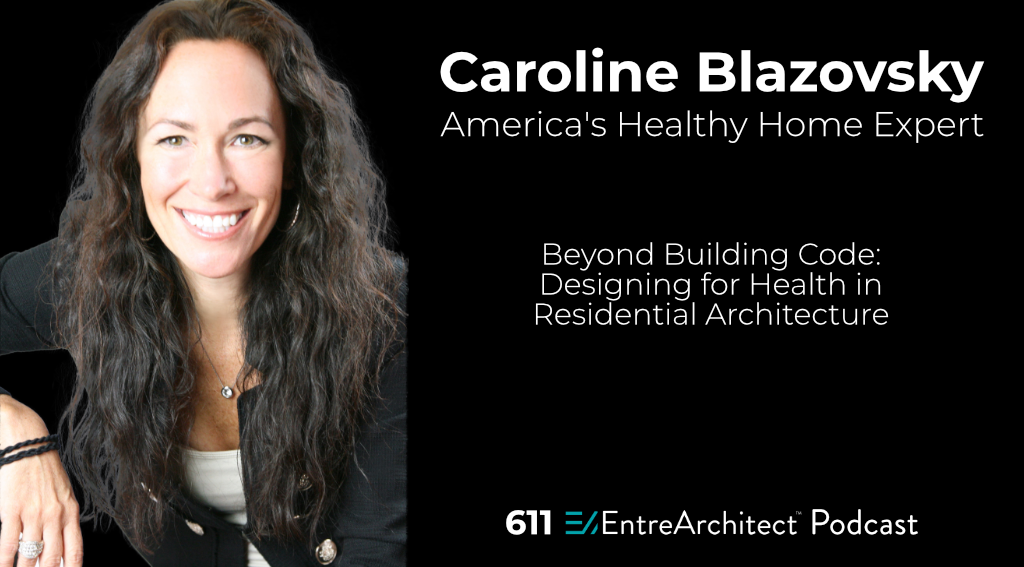
Why Indoor Air Quality, Materials, and Occupant Behavior Matter More Than Ever
When it comes to designing homes, most architects can recite building code requirements in their sleep. But here’s the problem: the code is the minimum. And in today’s world, minimum isn’t good enough.
That truth hit hard during my recent conversation with Caroline Blazovsky on the EntreArchitect Podcast. Caroline is known nationally as America’s Healthy Home Expert. She’s not only investigated over 30,000 homes across the U.S. and abroad, but she’s also built a career helping people heal by fixing their buildings.
In this episode, we went deep on what it really takes to design a healthy home. And if you’re a residential architect like many of us in this community, these insights aren’t just helpful—they’re essential.
You can hear the full episode at https://entrearchitect.com/611, but here are the takeaways I believe every architect should absorb and apply.
The Most Important Design Tool: Listening
Caroline opened with something that hit close to home: every “healthy home” starts with understanding the people who will live in it. Their lifestyle, medical conditions, sensitivity to chemicals or mold, and even their ability to maintain a high-performance home all matter.
Designing for health starts with listening. Because a high-tech ventilation system won’t make someone healthier if they never change the filters.
Why “Green” Doesn’t Always Mean “Healthy”
We’ve all been trained to specify materials based on sustainability, low VOC, and third-party certifications. Caroline challenged that.
Just because a product is “green” doesn’t mean it’s safe. Natural ingredients like citrus oils or pine terpenes may sound clean, but in high concentrations they can be just as reactive as synthetic VOCs. The key, she says, is understanding the total chemical load of a home—not just whether a product made the LEED list.
As architects, we must rethink how we evaluate materials. Durability, moisture resistance, and chemical stability need to sit alongside aesthetics and environmental impact.
Code Is Not Enough
Caroline was blunt: building code is the bare minimum. And minimum standards won’t protect your clients from the hidden hazards in today’s construction industry.
She sees it every day—homes filled with toxic glues, OSB panels that off-gas for years, poorly installed ductwork lined with fiberglass, and HVAC systems that trap moisture and circulate mold spores.
Designing for health means building above code. It means choosing materials and systems based on performance in real-life environments, not just lab tests or manufacturer brochures.
You Can’t Design What You Don’t Understand
As architects, many of us default to leaving HVAC design to the engineers or the mechanical contractor. But Caroline made it clear: HVAC is the heart and lungs of the home. And it should be one of the first things we think about—not the last.
Poor duct layout. Interior fiberglass linings. Flex duct installed with dips that collect moisture. These are common failures in today’s construction—and they have direct consequences for occupant health.
If we truly want to build homes that perform, we must understand how these systems work, how they fail, and how to design better alternatives.
Light as a Building Material
We also talked about natural light—not from an aesthetic perspective, but a biological one.
Caroline recommends designing for 30% window coverage in every room. Why? Because light—real, full-spectrum light—is fundamental to human health. It impacts everything from mood to hormone production to immune function.
And while low-E coatings and argon-filled glazing may be great for energy efficiency, they often block the wavelengths our bodies need most.
This is a design conversation we need to be having. Not just where the windows go, but how they affect the occupant’s well-being.
Rethinking What “New” Means
Caroline said something that struck me: “People think new homes are perfect. But perfection doesn’t exist in construction.”
She’s right. In fact, many of the homes she investigates are brand new—and already making their occupants sick. Builders cut corners. Workers leave trash in ductwork. Materials off-gas. And the “tight building envelope” becomes a trap for pollutants when mechanical ventilation is inadequate or poorly designed.
That’s not to say new construction is bad. It’s to say that thoughtless construction—especially at scale—is dangerous. And it’s architects who are in the best position to change that.
The Business Opportunity for Architects
Let’s look beyond health for a moment and talk business.
There are millions of homes being built right now across the country. Many of them are, frankly, garbage. In 10 years, they’ll need full renovations. And when those homeowners realize their beautiful suburban house has a mold problem, chemical sensitivities, or a failing HVAC system, they won’t call the builder.
They’ll call you—the architect who knows how to fix it.
This is a future for residential architecture: retrofitting unhealthy homes for human well-being. It’s a market opportunity with no ceiling.
One Simple Recommendation
Caroline ended our conversation with a practical tip I want to pass along:
Get a mold and water damage rider on your homeowners insurance.
It’s cheap, it’s often overlooked, and it could save you or your clients tens of thousands of dollars when—not if—a leak happens.
Even more importantly: educate your clients to do the same. These are the small details that make you a trusted advisor, not just a designer.
The Future Is Bright—If We Build It That Way
Caroline is optimistic. She sees the industry shifting from green to healthy. From sustainable to livable. And the technology—air quality sensors, circadian lighting, building science-backed materials—is improving every day.
Clients are becoming more aware. Doctors are referring patients to environmental consultants. Architects have an opportunity—and, I believe, a responsibility—to step into this new role as health-centered designers.
Let’s build homes that heal. Let’s move beyond the code. Let’s design for health, because that’s where the future of architecture is headed.
To hear my full conversation with Caroline Blazovsky, visit https://entrearchitect.com/611. I promise it will change how you think about the homes you design.

Leave a Reply